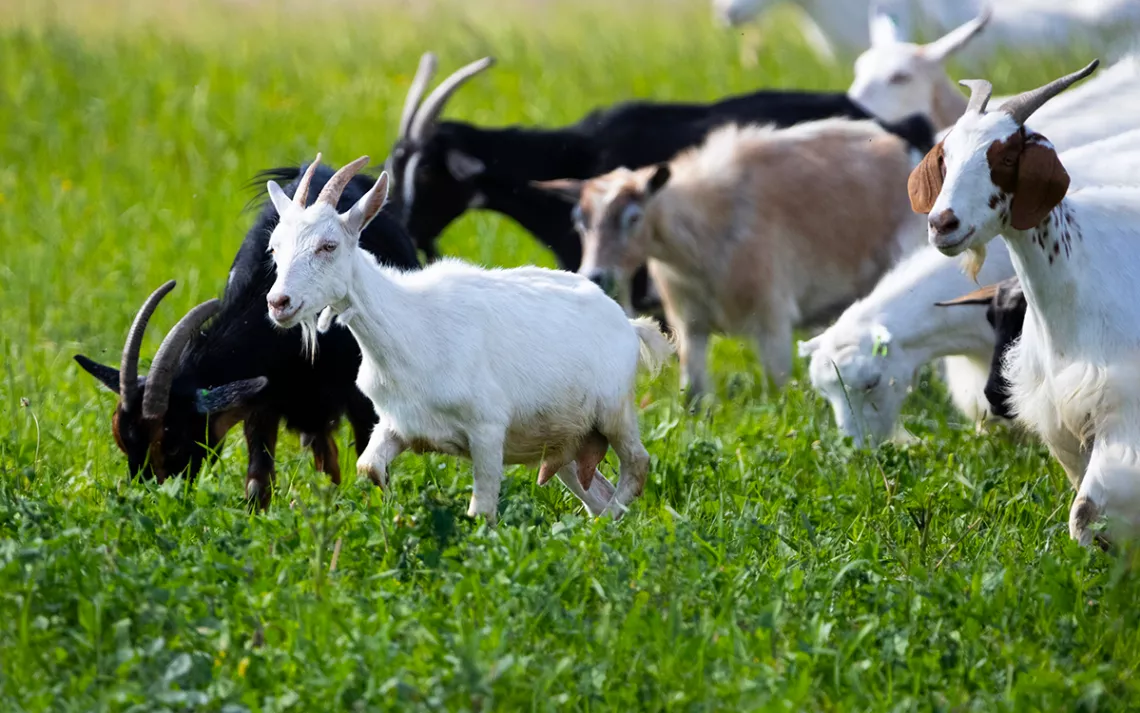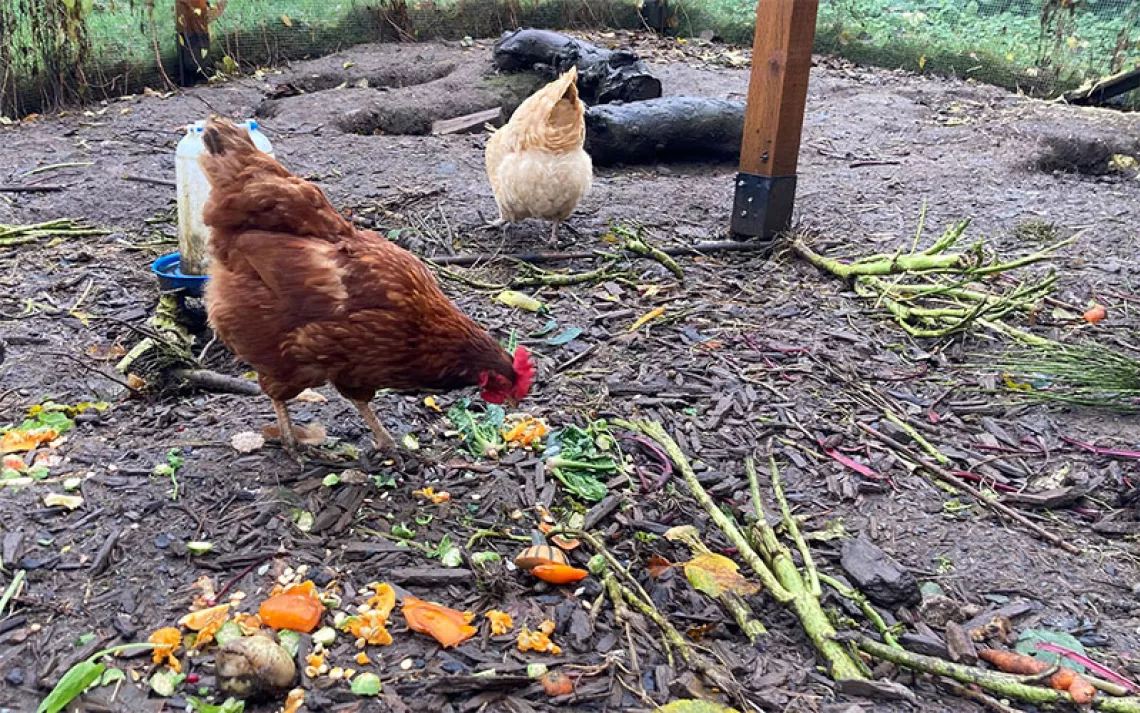Is Eating Goat Meat Green?
Fact-checking sustainability claims about the trending ruminant

Photo by Viktoriia Kovalova/iStock
Niman Ranch founder Bill Niman became famous—and built a fortune—from selling beef, but in the years since, he’s fallen for another ruminant. Goats, he argues, can improve rangeland quality for other farm animals. And, when they're raised in the right conditions, Niman thinks they’re delicious. “If we were more attuned to nature and where our food came from, we would probably celebrate goat meat more,” he said.
In 2008, Niman partnered with Rob and Michelle Stokes on a small commercial goat operation, which the Stokes have since grown into Oregon’s Malheur River Meats, producing grass-fed goat meat along with beef and pork. It’s part of a broader trend. According to the US Department of Agriculture, goats are now the fastest-growing livestock segment in the country, with more producers entering the market each year. While the US still imports most of its goat meat from Australia and New Zealand, domestic production of goats has increased more than 300 percent since 1999.
That growth is driven, in part, by immigrants arriving in the United States from places that celebrate goats, including the Middle East, Latin America, and the Caribbean. And, goat-loving chefs and restaurateurs like Erik Ramirez, Stephanie Izard, and Scott Conant are putting the meat on prominent menus. In recent years, Mexican birria, often made with roasted goat meat, has trended across the US.
It’s not just about flavor. Aficionados also point to goat’s compelling nutritional chops: Compared with other red meats, it is higher in vitamins and lower in saturated fat and cholesterol. And many proponents stress its environmental benefits as an alternative to other meats. Founders of the international Goatober festival tout goat as the “world’s most sustainable meat,” which made us wonder: Are goats really green?
One central claim is that goats don’t require the kind of high-quality land that other food sources need. “Most of the time, goats are grazing in pasture that generally isn’t suitable for crop production because it’s too dry, rocky, or steep,” said Melanie Barkley, senior extension educator at Penn State Extension. Barkley works directly with sheep and goat producers, observing firsthand how some farmers convert otherwise low-value land into viable businesses.
And on that marginal land, goats can contribute to soil health. Goats are often used to clear fields of unwanted or invasive weeds, such as poison ivy, along with thorny plants other livestock won’t eat. In addition, plant seeds retain only 20 percent of their viability after passing through small ruminants, reducing the need for chemical herbicides on farms.
“Goats have been used in California for fire suppression and in the Southeast to control kudzu and other invasives,” explained Nina Prater, a sustainable agriculture specialist at the National Center for Appropriate Technology. Prater and her husband run a small-scale livestock operation in Arkansas and raise a herd of goats for meat. If left unmanaged, goats can destroy an ecosystem, as they did in the 19th century when abandoned on islands as food for future shipwrecked sailors. But since goats love to eat nutrient-packed roots and leaves, goat manure is especially rich in minerals. And when carefully tended, Prater explained, goats can contribute to healthier soils. “With proper management, as small ruminants graze, they build the soil’s health, which in turn stores more carbon from the atmosphere,” she said.
Goats may also be better able to adjust to a changing climate. Most domestic goat meat comes from the Southwest, where producers in states including Texas and Arizona manage large goat herds in arid conditions. Producing one kilogram of goat meat uses 4,000 liters of water. That’s more than chicken (3,900 liters of water/kg) but compares favorably to pork (4,500 liters/kg), lamb (6,000 liters/kg), and especially beef (14,800 liters/kg).
Of course, meat production doesn’t simply respond to a changing climate; it’s a significant driver of the climate crisis. Together, meat and dairy account for around 14.5 percent of global greenhouse gas emissions. That’s led, increasingly, to calls for a more plant-based diet.
One culprit is the greenhouse gas methane: All ruminants, which include sheep, goats, and cows, expel some amount of methane (CH4) gas as they digest their food. That’s a significant challenge to goat proponents’ sustainability claims. A 2021 study calculated goats’ per-kilogram methane emissions at 3.8–5.5 kg of CH4, an output that’s on par with sheeps', and even higher than a cow’s 3.5–4.2 kg CH4 per kg of meat.
When it comes to CO2, however, goats pull ahead in the ruminant race. Sheep and goats generate per-kilogram emissions of around 23.8 kg CO2, the United Nations Food and Agriculture Organization estimates. Cows clock in at a whopping 46.2 kg CO2 per kg of meat. (Plant proteins have a dramatically lower environmental impact than any of these; a kilogram of soybeans or peas generates just one to two kilograms of CO2.)
The verdict? When it comes to goat meat’s environmental impact, the results are mixed. When properly managed, goats are great for soil health. They don’t require as much high-quality rangeland or use as much water as cows. But, despite their meat’s better-than-beef carbon output, goats’ high methane emissions are really tough on the climate.
In the end, going green means choosing plant-based protein over meat. But in a country that eats nearly 60 pounds of beef per capita annually, swapping some or all of that beef for goat could put a meaningful dent in carbon emissions. If someone with a typical American diet replaced beef with goat meat, for example, it would reduce their annual dietary carbon footprint by about 40 percent.
So next time you’re craving carne asada—and if no plant-based alternative will do—consider trying birria instead.
 The Magazine of The Sierra Club
The Magazine of The Sierra Club



